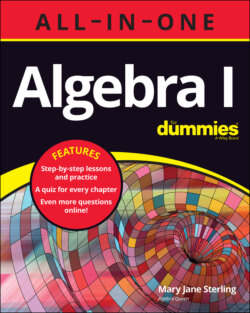Читать книгу Algebra I All-in-One For Dummies - Mary Jane Sterling, Mary Sterling Jane - Страница 34
Answers to Chapter 1 Quiz
Оглавление1 . All of the terms are rational except for . The number is an integer and is rational, because it can be written as a fraction such as . The number is already written as a fraction and is rational. The number is a terminating decimal and can be written as or . The number 102 is a whole number and can be written as a fraction over 1. The number is imaginary, so it can’t be a rational number.
2 C. 14. Replacing the x with 5, you get , which is not equal to 3. Replacing the x with , you get , which is not equal to 3. Replacing the x with 15, you get , which is not equal to 3. Replacing the x with 16, you get , which is not equal to 3. Replacing the x with 14, you get , which IS equal to 3.
3 1. The 2x multiplies a binomial, making the expression all one term. There are two terms in the parentheses, but the expression is still just one term.
4 2. There are two exponents, each on the terms in the parentheses. They are both 2.
5 B. The answer only multiplies the x and not the 8. The answer finds the sum of x and 8, not the difference. The answer has the 4 multiplier in the denominator instead of the numerator. And the answer has reversed the numerator and denominator.
6 . The quotient refers to division, and the sum refers to addition. The point of the symbol faces the smaller side.
7 . The difference refers to subtraction, and the product refers to multiplication. The point of the symbol faces the smaller result.
8 3. The three terms are separated by the two subtraction symbols.
9 3. The number 3 divides each of the terms evenly (leaving no remainder).
10 All of the terms are real except for . The number is a repeating decimal and is a rational number; it can be written as or . See Chapter 4 for more on repeating decimals. The number is a rational number and so is real. The number is equal to 2,809 and is a whole number. And is a rational number, already written as a fraction. The number has the imaginary factor of i, so it is imaginary and not real.
11 1. The number 1 is a term that stands alone and isn’t multiplying or dividing any other number. The 4 and 9 are both part of the coefficients of their respective terms.
12 5. The 5 multiplies the variable x.
13
The number line is broken up into units of 0.2 in length. The number has to be estimated, as it’s halfway between and . The other two numbers have tick marks to rest on.
14 . The “wavy equal sign” symbol means the answer is approximate and has been rounded.
15 . The two terms are combined by subtracting 1 from 4. The two constants are added together.
